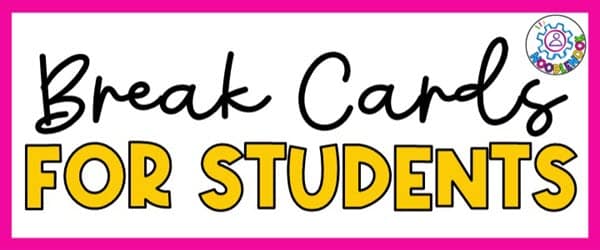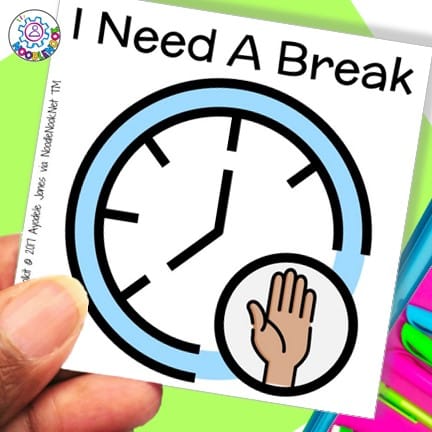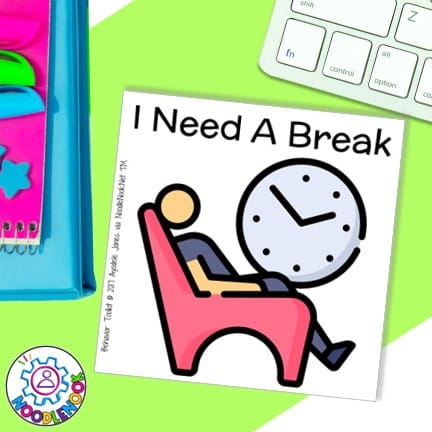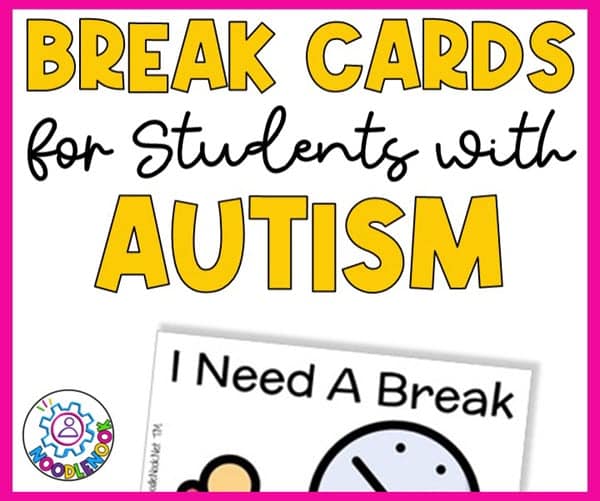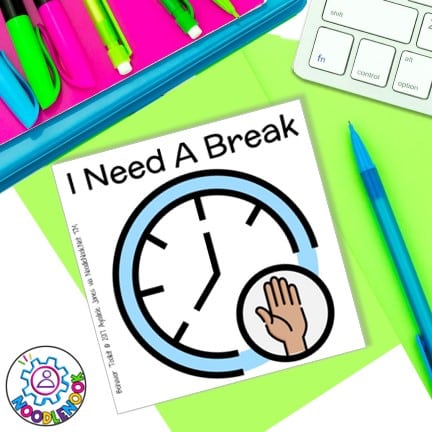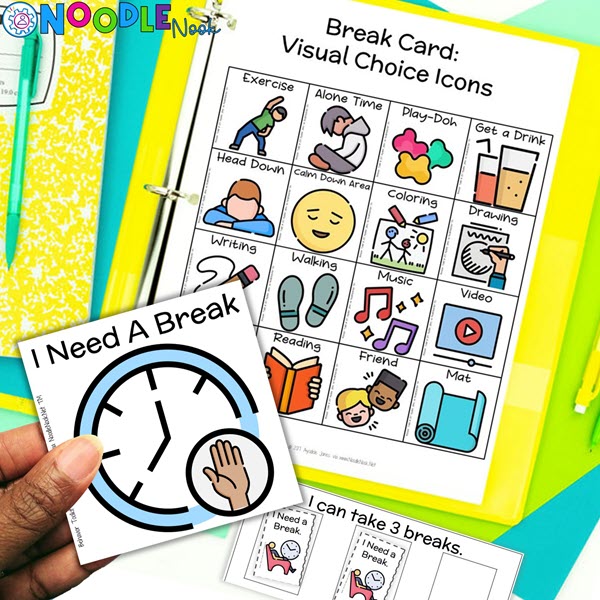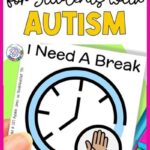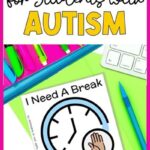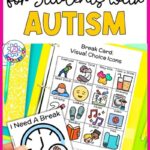In the classroom, special education teachers often encounter inappropriate behavior. One valuable tool to navigate these challenges and provide support is a break card, especially for special education students, like those with an autism spectrum disorder. But what exactly is a Break Card, and how can it be a game-changer in your classroom? Let’s dive in and explore break cards for students with autism (and their teachers too).
What is a Break Card?
A break card is a straightforward yet powerful tool used to help students cope with emotional overwhelm, stress, or the need for a moment to regroup. It’s a small visual cue, often a card or a signal, that provides students with a proactive way to communicate their emotional needs. When a student with special needs feels overwhelmed, frustrated, anxious, or in need of a breather, they discreetly show the break card, signaling their teacher or staff that it’s break time.
This unassuming card can be a lifeline for students who may struggle with emotional regulation or have difficulty expressing their feelings in a prosocial way. It’s also a great self-reflection tool for identifying needs and feelings before they blow up into unwanted behaviors. So, now that you know what they are, let’s explore why and when you might use break cards for students with autism in your classroom.
Why You Might Use a Break Card in the Classroom
In the daily hustle and bustle of a classroom, every student’s needs are unique. The break card, a simple yet powerful tool, can play a pivotal role in creating an inclusive and supportive learning environment. There are several reasons why you might want to incorporate break cards into your behavior toolbox within the classroom. They are especially useful when dealing with the following:
Emotional Overload: Students can use break cards when they experience a surge of overwhelming emotions. The card offers a way to take a step back and regain composure before emotions get out of control.
Frustration: When students find a task challenging or encounter difficulties, a break Card provides an opportunity to step away. In this time, a student can refocus and return to the task with a fresh perspective.
Sensory Overstimulation: Some students may become overwhelmed by sensory inputs in a busy classroom environment. A break card allows them to take a break from sensory activities and come back when they’re ready.
Anxiety: Break cards serve as a lifeline for students dealing with anxiety or stress. They may access a calm-down corner or do some deep breathing exercises during their break. Taking a moment to collect themselves can make a significant difference in their ability to engage in classroom activities.
Self-Regulation: For students who are learning to manage their emotions, a break card encourages proactive self-regulation. It offers a positive way to seek a break before emotions escalate into disruptive behaviors.
Preventing Escalation: As the teacher, you can proactively use a break card as a preventative measure. When you see a student who needs a break, you can use the card to stop certain behaviors from escalating into more disruptive or challenging ones.
With so many benefits to students using break cards, it’s a wonder they don’t come preprinted and ready to go for all special ed teachers on the first day of school!
Who Benefits from Using Break Cards?
Obviously, students in special ed who struggle with any of the above can benefit from using a break card. But maybe you aren’t in special education or life skills. Maybe you’re a general ed teacher wondering if these cards will work for specific students who are not receiving special ed services. The answer is YES!
1. Students with Short Attention Spans: Some students find it challenging to maintain focus for extended periods. A break card offers them structured breaks to recharge and return to tasks with renewed attention and energy.
2. Students with Work Stamina Challenges: For students who struggle with prolonged work periods, a break card provides a chance to manage their stamina effectively. Short breaks help them pace themselves and stay engaged throughout the day.
3. Students with Impulse Control Issues: Students who grapple with impulsive behaviors can use a break card to take a moment and consider their responses. This tool empowers them to make more thoughtful choices in their interactions and actions.
4. Students with Sensory Sensitivities: Students on the autism spectrum or with a sensory processing disorder benefit from a break card when they experience sensory overload. These breaks allow them to self-regulate and prevent sensory meltdowns.
5. Students with Emotional Regulation Difficulties: For students who struggle to manage their emotions, a break card provides a non-confrontational way to request a break. This encourages them to proactively address their emotions and prevent emotional escalations.
6. Students on Individualized Education Programs (IEPs): Inclusive education settings often have students with IEPs that require additional support. A break card can be tailored to align with the specific needs and goals outlined in their IEPs, promoting a supportive and inclusive learning environment.
7. Students with Communication Difficulties: For students who struggle with functional communication, having access to necessary visual supports, especially in a mainstream classroom, is essential. Providing early intervention tools like these are super helpful for social emotional learning across all subject areas.
And don’t forget, a break card benefits YOU as the teacher! When you can be proactive with students and get out in front of their nonpreferred behaviors, it’s a game-changer! Instead of always reacting to negative behavior, you’re helping these students avoid them altogether. What’s more, because they’re able to better regulate their behaviors, your classroom climate is more conducive to learning for all students. As an intervention, break cards for students with autism, for neurotypical students, and teachers work wonders!
How to Implement Break Cards
Implementing break cards in your classroom can be a transformative process. These break card resources work with elementary-aged to high school students and are a perfect visual cue system in any school setting. Here’s a user-friendly, practical guide to integrating this tool into your teaching routine:
1. Introduction to Break Cards Sit down with a student and explain that these little cards are just for them when they need a breather. Let them know it’s perfectly fine to ask for a break. Be sure to use picture communication symbols that make sense to the student or explain them during this intro.
2. Recognizing When to Use Break Cards Remind the student to not abuse the cards. Teach them to tune into their emotions and recognize when they’re feeling overwhelmed, frustrated, or simply need to move around. This self-awareness is essential for lifelong success. Cover with the student where they can go and what they can do when they take their break. You may have a calm down area or a student may go for a walk. Whatever the plan, set it up before you start using the cards.
3. Signaling the Need for a Break Break cards work best when they’re discreet. Encourage your students to signal their need for a break without causing disruptions. A subtle show of the card is all it takes. This subtle signal is an important component, so keep this signal just between you two.
4. Acknowledging the Break Signal When a student shows their break card, be quick to acknowledge it. A simple nod or a warm smile lets them know you’ve got their back and that their feelings are valid.
5. Returning from the Break After a break, check in with the student. Ask them how they’re feeling and if they’re ready to rejoin the activity. Make the transition back as smooth as possible to maintain the flow of learning. By doing so, students learn to keep in touch with their own behavior and feelings.
6. Reinforce with Positivity Praise and commend students for using break cards to express themselves. Encourage them to continue this brave and responsible practice. A little positive reinforcement goes a long way. Plus, it’s a great way to keep students motivated and engaged.
7. Consistent Support Encourage your students to practice using break cards even during non-stressful times. This helps them feel more comfortable using them when needed. Keep break cards accessible and visible to ensure students can access them at any moment.
With these practical steps, you’ll be on your way to creating a more inclusive and supportive classroom environment. This is all about getting students what they need when they need it. Remember to cover with a student what is acceptable when on a break and how long a break can last. Setting expectations before you dive in will keep any bumps in the road to a minimum. It will help you to manage behavioral issues before they happen as well.
Want a FREE PDF of this article to help you implement break cards for students with autism in your classroom? Just Click HERE to get your copy!
What To Do When Things Go Wrong
I would love to tell you that implementing these break cards will be seamless. This, however, is the real world, and it is often not how we planned. When you run into challenges, don’t panic… we have a plan!
Stay Calm. If a student experiences difficulties, you must maintain your composure. While it can be frustrating you will need a lot of patience as you work with students to implement this appropriately.
Have a Talk. Take a moment as soon as possible to have a conversation with the student privately. Be sure to move away from the group as you work to understand. Use active listening to grasp the students’ feelings and get a sense of their needs.
Reteach and Review. Once you have a better understanding of how the student is struggling or getting caught up with the system, it’s time to reteach and review. Review your expectations and reteach all of the pieces to use the break card appropriately. If needed, model and practice each section with the student.
Adapt and Modify. Remember, this strategy is about helping the student to better manage and self-regulate. Be flexible in adapting your approach and how the student uses their break card. What works for one student may not work for another, so really consider how you can adjust accordingly.
Reinforce Positivity. Although we may be dealing with negative behaviors, as a teacher we always want to stay positive. Help foster a positive and supportive environment within your classroom and emphasize that it’s okay to face challenges and work to find solutions. If you stay positive, it will help your students to stay positive. By following these steps, you’ll be able to handle it when things go awry while using break cards.
If you feel like you are struggling, then get help from the team! Call in your school counseling team members, speech therapy provider, and possibly your physical therapy and occupational therapy providers as well. They may all have ideas on where breakdowns are happening within the special education classroom specific to a student’s needs. They may also want to steal your awesome ideas for their therapy room.
Sample Scenarios
It might help to see some real-life situations where break cards can make a significant difference in the classroom. Here are a few that might resonate with you as a classroom teacher working in which school, middle school, or in elementary with young people:
Eloping Student: You may have a student who tends to elope or flee from the classroom when they feel overwhelmed. Your primary objective might be to keep them in the classroom. Teach them to use a break card when they feel overwhelmed to access a safe space within the classroom, like a calm-down corner. Once the student has regained their composure, support them in returning seamlessly to the activity or task they were working on. When a student has an appropriate way to request a break, they are less likely to elope.
Wandering Within the Room: You may have a student who frequently wanders within the classroom, making it challenging to focus on tasks. It may also be disruptive for other students. First, it’s essential to find out why the student is wandering. If it’s due to restlessness, implement a break card where a student is allowed to move to a designated break area within the classroom. Within that space, they should have permission to pace, use adaptive seating tools, or simply stand and work. Once the student has spent some of their energy and had some movement breaks, help them to transition back to their seats and resume their learning tasks.
Head Down During Activities. You may have a student who often puts their head down during academic instruction activities. While this can be caused by a knowledge gap where students struggle with the learning material, sometimes it is because of sheer overwhelm. By implementing a break card, you can help a student use more prosocial strategies to support them in these situations. They may access a specific learning area where they can get peer or paraeducator support. However you choose to address this, it’s better than them checking out altogether. If you notice a lot of students with this same behavior needs, then look at your lesson plans for places to add more brain breaks. If you need Brain Break Resources, check this out.
Overstimulated by Sensory Inputs: Some students may become overwhelmed by sensory inputs in a busy classroom. Implementing this system with these students provides them with a means to request a sensory break. When a student uses their break card, allow them access to a space within the classroom where they can self-regulate. This may be by using noise-canceling headphones or by sitting in a way that minimizes visual input. When a student is ready, they return to the more traditional learning environment and continue with their tasks.
Anxious Student: You may have a student who is experiencing heightened anxiety and stress. Your primary objective is to keep them from reaching a breaking point. By implementing this system, you offer students a non-disruptive way to communicate their needs for a moment of calm. In doing so, you can support their emotional well-being and reduce anxiety-related disruptions. A student may remove themselves from the learning task to practice breathing exercises or calming strategies. When they are ready, they can return to their work.
In each of these scenarios, you can see how important it is to use the implementation strategies listed above. We want students to have all of the tools necessary to use their break cards appropriately to meet their needs. Since break cards are so helpful in multiple situations and with a variety of students, be thoughtful of how you can use them to meet the specific needs of specific students.
RECAP: Break Cards for Students with Autism
The title of this post was misleading. If you’ve gotten to the end, you realize that break cards work for students of all sorts, not just those with autism. Unfortunately, this amazing tool is often relegated as a visual only for students with autism. That is simply not true! If you are struggling with student behaviors and classroom management, you may be able to better manage it all with this intervention system.
If you want some great printable break cards for your students, check out the ones in the Behavior Toolkit. With so many intervention strategies and visual resources to manage behavior, you will have your class on point in no time! Get yours here: The Behavior Toolkit via NoodleNook

